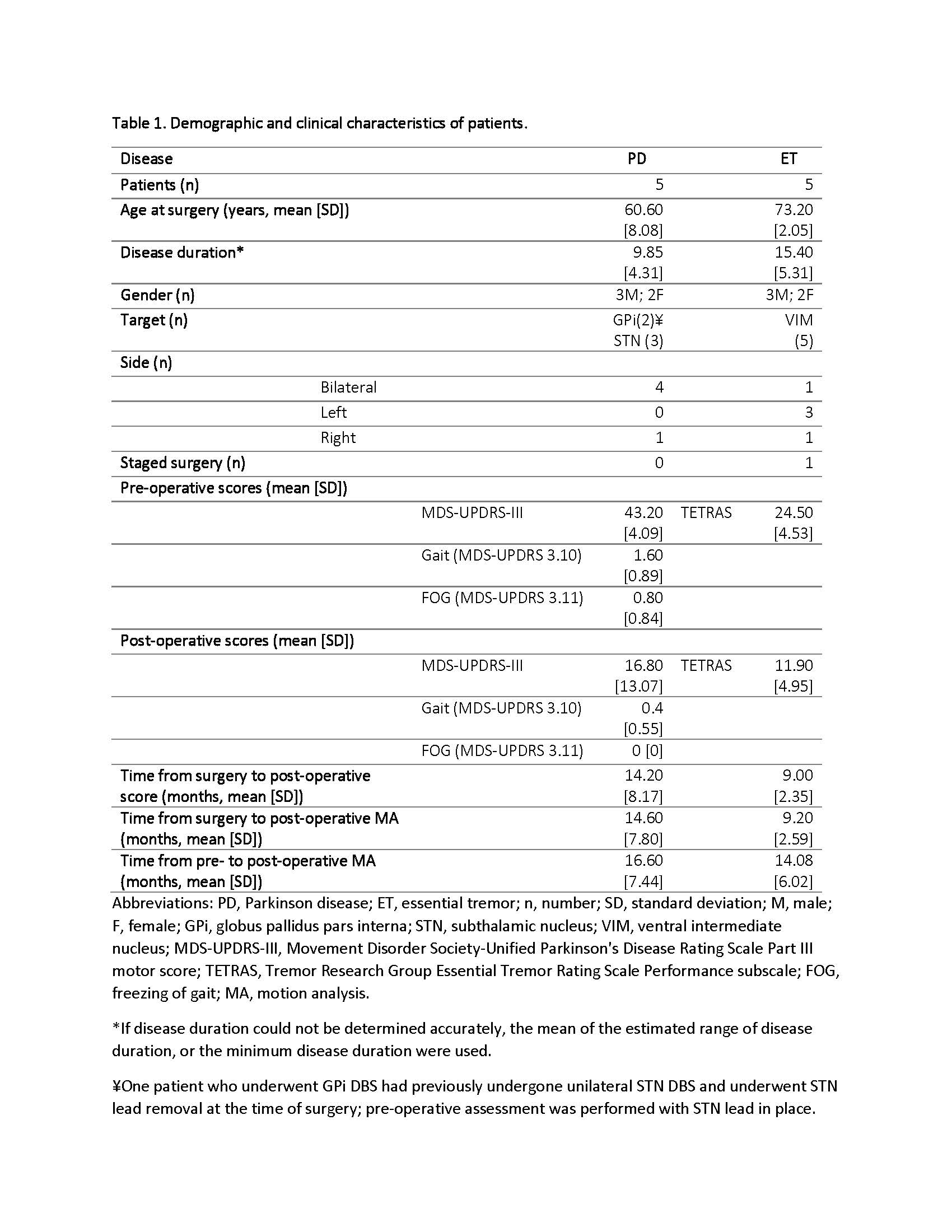Objective: To determine the change in gait parameters following deep brain stimulation (DBS) in Parkinson disease (PD) and essential tremor (ET).
Background: DBS is an established treatment for akinesia, rigidity, and tremor in PD as well as for medication-refractory ET. However, its effects on gait are less understood [1, 2, 3].
Method: Database review from our kinematics laboratory between 2019 to 2022 identified 10 patients (5 PD; 5 ET) that had pre- and post-operative DBS quantitative gait kinematics measured via a 3D commercial motion analysis (MA) system. Pre- and post-operative assessments were performed in the medication off state for PD patients. Post-operative assessments were performed in the stimulation on state for all patients. Changes in gait outcomes from pre- to post- were expressed as effect sizes (Cohen’s d) and categorized as “small,” “medium,” or “large” using established cutoff values. Due to sample size limitations and the preliminary nature of the study, no null hypothesis testing was performed.
Results: Patient demographics and clinical data are outlined in Table 1 [table1]. Mean Movement Disorder Society-Unified Parkinson’s Disease Rating Scale Part III motor score improved from 43.2 to 16.8, and mean Tremor Research Group Essential Tremor Rating Scale Performance subscale score improved from 24.5 to 11.9 at the post-operative follow-up. Step length and speed increased in patients with PD (Cohen’s d=0.90 and 0.45, large and medium effects, respectively), but decreased in patients with ET (-0.33 and -0.55, small and medium effects, respectively). Cadence decreased in both groups (-0.61, PD; -0.81, ET). A medium reduction (-0.67) in swing phase % was observed in ET; no other non-negligible changes in gait outcomes were observed. Figure 1 summarizes the changes in gait parameters following DBS [figure1].
Conclusion: DBS generally improved pace-related gait parameters in patients with PD, while a worsening was noted in patients with ET. Further work-up with larger sample size is warranted to evaluate long-term and target-specific effects of DBS on PD and ET. These studies will aim to develop MA into an objective tool for DBS patient and target selection.
References: [1] Cossu G, Pau M. Subthalamic nucleus stimulation and gait in Parkinson’s Disease: a not always fruitful relationship. Gait Posture. 2017 Feb;52:205-210. [2] Mei S, Eisinger RS, Hu W, Tsuboi T, Foote KD, Hass CJ, Okun MS, Chan P, Ramirez-Zamora A. Three-Year Gait and Axial Outcomes of Bilateral STN and GPi Parkinson’s Disease Deep Brain Stimulation. Front Hum Neurosci. 2020 Feb 11;14:1. [3] Earhart GM, Clark BR, Tabbal SD, Perlmutter JS. Gait and balance in essential tremor: variable effects of bilateral thalamic stimulation. Mov Disord. 2009 Feb 15;24(3):386-91.
To cite this abstract in AMA style:
P. Testini, G. Skelton, D. Bernhard, S. Miocinovic, P. Aia, C. Buetefisch, L. Higginbotham, L. Scorr, S. Triche, J. Mckay, C. Esper. Preliminary estimates of the effects of deep brain stimulation on gait kinematics in Parkinson disease and essential tremor. [abstract]. Mov Disord. 2022; 37 (suppl 2). https://www.mdsabstracts.org/abstract/preliminary-estimates-of-the-effects-of-deep-brain-stimulation-on-gait-kinematics-in-parkinson-disease-and-essential-tremor/. Accessed April 26, 2025.« Back to 2022 International Congress
MDS Abstracts - https://www.mdsabstracts.org/abstract/preliminary-estimates-of-the-effects-of-deep-brain-stimulation-on-gait-kinematics-in-parkinson-disease-and-essential-tremor/

